The Brazos Performance Preview: AMD E-350 Benchmarked
by Anand Lal Shimpi on November 16, 2010 12:01 AM ESTMobile IGP Comparison
I narrowed down the platforms for our mobile IGP comparison. I simulated a Core i3 350M by taking an i3-530, underclocking it (I couldn't do anything about the 4MB vs. 3MB L3 cache) and capping its GPU frequency at 667MHz. This is the best case scenario for the i3-350M, and as you'll see below, it doesn't really matter. I also paired a 2.2GHz Pentium Dual-Core with a G45 motherboard, agian simulating the cheaper mobile Pentium platform. Finally I installed Windows 7 on the 1.6GHz Core 2 Duo based 11-inch MacBook Air with its GeForce 320M to give you an idea of the upper bound for mobile performance with what might as well be a low end discrete GPU.
Updated: I've added performance results from a simulated Core i3-330UM, the E-350's competition in ultra portables.
We'll start with Modern Warfare 2:
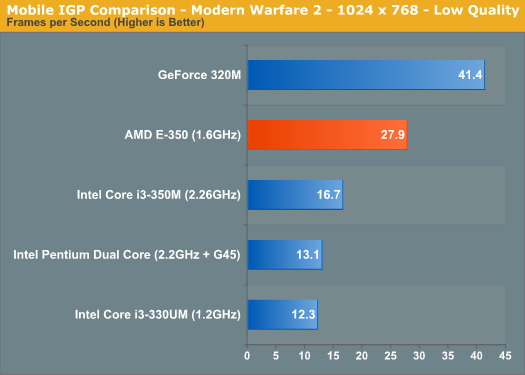
The E-350 puts the i3-350M, i3-330UM and Pentium DC to shame, delivering 67% better performance. The frame rate is just shy of being totally smooth however. I found that in most modern games 1024 x 768 would result in frame rates just under 30 fps.
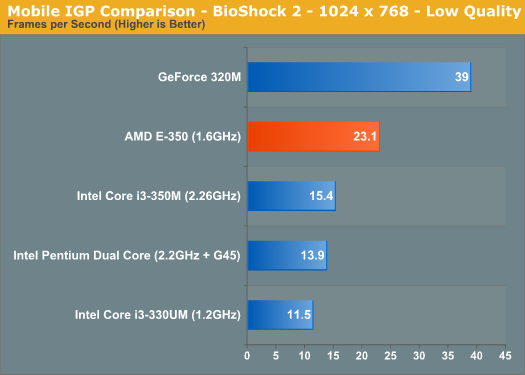
BioShock 2 showed a similar performance advantage. Again we're not able to break 30 fps but the performance advantage is huge compared to the Intel platforms with integrated graphics.
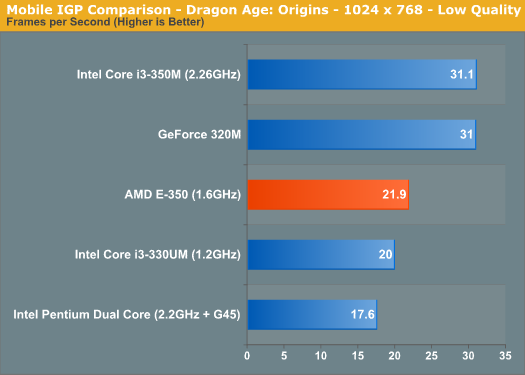
Dragon Age: Origins is mostly CPU bound at low quality settings and thus there's no real advantage to the E-350's Radeon HD 6310 GPU. It's faster than the Pentium/G45 platform, but significantly slower than the i3-350M. I expect most games however to be GPU bound at these settings across the board.
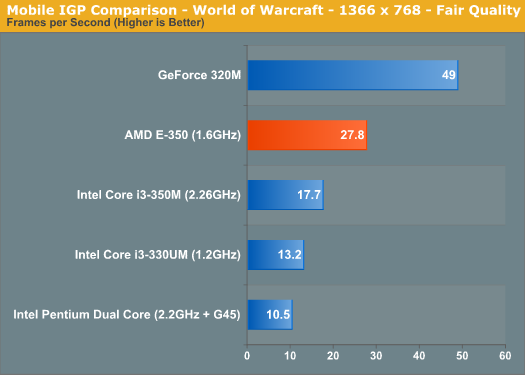
World of Warcraft continued the trend. The E-350 ended up 57% faster than the i3-350M, although still fell short of a discrete GPU.
Of course I wondered how well Brazos would play Starcraft 2:
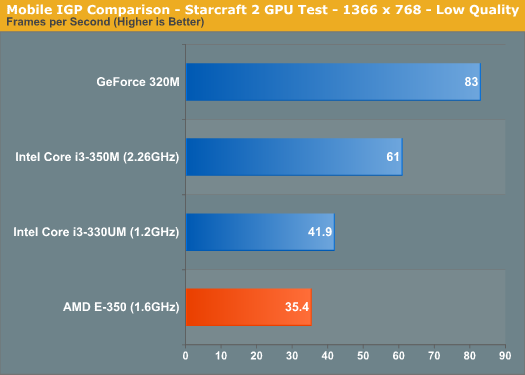
The GPU handles SC2 just fine, however the game is very CPU dependent and thus you see a pretty big advantage from the mainstream i3 system. The comparison is a lot closer when we look at the i3-330UM. The E-350 won't be able to play SC2 as well as a $500 mainstream notebook, but it'll be comparable to an ultraportable running ULV Arrandale.
We don't have numbers for the G45 platform here because the system wouldn't run our benchmark (our tests use an older version of SC2 which apparently had issues with the G45 drivers).
Our SC2 CPU test gives you an idea of the lower end of performance in large multiplayer battles:

The E-350 offers only 58% of the performance of the i3-350M system. The Bobcat cores do hold the platform back from time to time. Again, compared to the i3-330UM there's no performance difference at all.
Just for kicks I also ran the Civilization V benchmark, which gave us two datapoints: GPU performance and no-render/CPU performance.
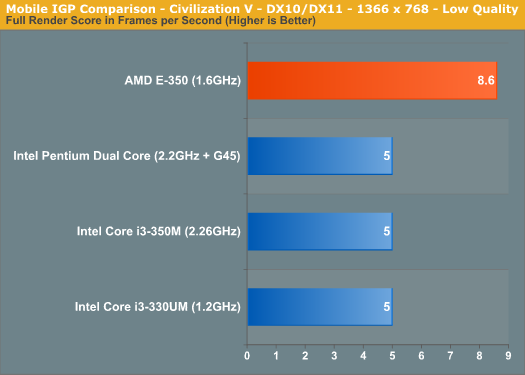
The benchmark doesn't score well on either platform, although AMD does hold a 72% performance advantage over the i3 and G45 platforms. The CPU test puts the E-350 at about 55% of the speed of the Pentium dual core platform.
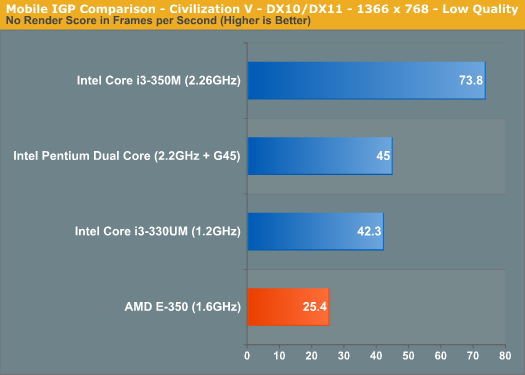
Civ V is one area where the Arrandale CPU advantage wins out over GPU performance.
Overall, the E-350 has no problems outperforming any of the current Intel integrated graphics offerings in 3D games. In CPU bound titles the E-350 loses out to the mainstream i3, but is competitive with ultra low voltage i3s. Just as with Atom, you'll have to sacrifice performance vs. a mainstream notebook, but compared to low voltage Arrandale the E-350 can hold its own.










207 Comments
View All Comments
silverblue - Wednesday, November 17, 2010 - link
I admit it's rather one-sided, however there's an important point to be made - most graphics sales are integrated/low-end discrete. This is why Intel has the lion's share of the market. nVidia's fallen out of favour with Intel (and not because it did something wrong, either) and are soon to get a competitor in the ULV space which may just make purchasing ION a less clear cut decision.nVidia won't sit still, and I doubt Intel will in terms of on-die graphics. There's nothing to suggest that nVidia couldn't come up with an Optimus solution for the Brazos platform (as ironic as that may sound, though do remember it's hardly a graphics monster) in order to have as many fingers in as many pies at once. nVidia have produced very good chipsets in the past for both AMD and Intel and this alone should factor in system builders' purchasing decisions, let alone OEMs.
nVidia aren't going to die, far from it. The better they're doing, the more Intel and especially AMD have to lower prices to keep competitive.
nitrousoxide - Wednesday, November 17, 2010 - link
nVidia working on Optimus in co-op with AMD? That sounds like AMD saying to Intel: hey, use my GPUs on Sandybridge!silverblue - Wednesday, November 17, 2010 - link
By that I meant an nVidia chipset that employs a GPU switching mechanism should the x16 slot be populated.Rayb - Wednesday, November 17, 2010 - link
Just to make it clear, I understand the point you're making and the purpose of competition when a product is superior to a previous release. That's not the issue I'm debating, since the ION chipset is almost two years old and has managed to survive the ULV niche this long almost uncontested until now. I don't have any objections to Brazoz or Ontario if are proven even marginally better than other available alternatives.I don't restrict myself to one specific brand when making a purchase based on my requirements at that point. What I object is being marginalized to only one choice as alluded in (long rant by outsideloop) the third post above my reply. Which by the way since it's offset left and not intended for you, this one is.
According to his wisdom, there is no room for anybody else but his favorite company in that fantasy world. Obviously having having fruit-loops for breakfast, lunch and dinner is detrimental to your health.
nitrousoxide - Wednesday, November 17, 2010 - link
Hey about the 3rd question, 50 cents for a short post, 70 cents for a medium length post and 1 buck for a long post, that's how much those people are paid in my country :)plonk420 - Wednesday, November 17, 2010 - link
when it comes to raw CPU power, Brazos seems BARELY faster than Atom... and i feared Atom wouldn't be able to decrypt BD+ realtime with AnyDVD HD. i'm tempted to go Nano for that reason (but i sooooo want Brazos's TDP (even 25-50% more) for the Nano's computing power...nitrousoxide - Wednesday, November 17, 2010 - link
That's true in heavy multi-threaded work loads. Daily use featuring low-single-threaded work load is significantly faster than Atom. And it can at least play 1080p HD Video smoothly while an Atom struggles for 720p video playback. It is definitely faster than Atom, but how far it can go depends on its final price margin. If it is forced to encounter Sandybridge CULVs, it will definitely be wiped out.richough3 - Wednesday, November 17, 2010 - link
I currently have the Inspiron 1012 (Atom 450/GMA 3150) and the Inspiron 11z (SU4100 - 1.3 GHz/GMA4500MHD) and both have come close to what I've been looking for, but not quite.The 1012, Atom laptop, had awesome battery life, but it sucked at flash playback, running my TV tuner, and running multiple apps.
I got an Alienware M11x prior to the 11z. The graphics were awesome for an 11.6" subnotebook and battery life was good when on the integrated video, but the weight and hinge issue was why I returned it and got the 11z.
The 11z is good on battery life and did all the things the Atom laptop couldn't but it sucked for anything but basic running around in 3D games like Warcraft.
I had also considered the Inspiron M101z with the AMD K325, 1.3 GHz dual core proc, but it ran hotter and had less of a battery life than the 11z.
The E-350 APU appears to be able to address the desire for an acceptable, casual 3D experience and still provide decent performance for the other applications, along with good battery life and to provide all that in a lightweight subnotebook. Sure, I could get better performance with a heavier laptop, but I want lightness and a small footprint and I have a desktop for any heavy gaming or CPU intensive applications I want to run. I don't need a power hungry beast to play Plant vs Zombies, Diablo II, or to farm for mats in WoW, I just want it decent enough so it's not a total slide show.
iwodo - Wednesday, November 17, 2010 - link
There should be a price / performance / watt graph.Personally i am not too convinced this will succeed. Or this will solely complete where Atom is currently at, cheap and as apple correctly stated, useless Netbook area.
It is no where near even the low range Pentium E, or even Celeron.
The only area where Brazos or its derivative shines, is the cheapest computer possible.
However spending $40 - $50 you would get nearly double the performance.
Aloonatic - Wednesday, November 17, 2010 - link
I don't understand.DO you really think that Intel's product will be cheaper and improvements released more quickly without AMD as competition?
Mind boggled.